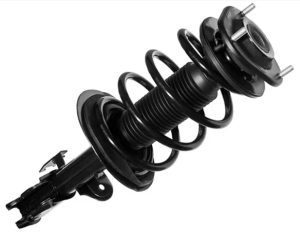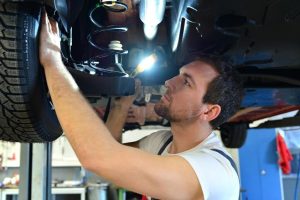A vehicle’s suspension system plays a crucial role in ensuring a safe, comfortable, and controlled ride. Two of the most vital components in this system are shock absorbers and struts. Though often used interchangeably, shock absorbers and struts have distinct functions and structures that contribute to vehicle stability and handling. Understanding how these parts work and recognizing when they need replacement can save you from costly repairs and enhance your driving experience.
What Are Shock Absorbers and Struts?

Shock Absorbers and struts are components designed to control the impact and rebound movement of your vehicle’s springs and suspension. They absorb and dampen the energy from road bumps and uneven surfaces to keep your tires in contact with the road, providing stability, steering control, and comfort.
-
Shock Absorbers are standalone devices that work with the suspension springs to absorb shocks from the road.
-
Struts combine the shock absorber and several suspension components into one unit, acting as a structural part of the suspension system.
How Shock Absorbers Work
Shock absorbers control the unwanted spring motion through a process called damping. Inside a shock absorber is a piston that moves through oil or gas within a sealed tube. When the wheel hits a bump, the spring compresses and expands, and the shock absorber slows this movement by forcing fluid through tiny holes or valves, converting kinetic energy into heat.
Key Functions of Shock Absorbers:
-
Reduce bouncing and swaying
-
Maintain tire contact with the road
-
Improve ride comfort and handling
-
Enhance braking performance by stabilizing vehicle weight transfer
How Struts Work
Struts perform the same damping function as shock absorbers but also provide structural support for the suspension. They often include a coil spring wrapped around the shock absorber, which helps support the vehicle’s weight and maintain ride height.
Functions of Struts:
-
Dampen road shocks and vibrations
-
Support the vehicle’s weight
-
Maintain alignment and suspension geometry
-
Serve as a mounting point for other components like the steering knuckle
Because of their structural role, a faulty strut affects not only ride quality but also the vehicle’s alignment and tire wear.
Shock Absorbers vs. Struts: Key Differences
| Feature | Shock Absorbers | Struts |
|---|---|---|
| Structure | Standalone component | Integrated with suspension parts |
| Function | Control spring movement | Control spring + structural support |
| Includes Coil Spring? | No | Yes |
| Role in Alignment | Minimal | Critical |
| Cost | Generally less expensive | Usually more expensive |
| Common Location | Rear or front suspension | Mostly front suspension |
When to Replace Shock Absorbers and Struts

Shock absorbers and struts wear out over time, typically lasting between 50,000 and 100,000 miles depending on driving conditions. Ignoring worn components can lead to poor vehicle control, increased stopping distance, and uneven tire wear.
Signs You Need Replacement:
-
Excessive bouncing after hitting bumps
-
Nose diving when braking
-
Vehicle swaying or leaning in turns
-
Uneven or rapid tire wear
-
Visible leaks or damage on the shock or strut
-
Clunking or knocking noises from suspension
How to Test Shock Absorbers and Struts
You can perform simple tests to check their condition:
Bounce Test:
-
Push down hard on one corner of the vehicle.
-
Release and observe the motion.
-
If the vehicle bounces more than 2-3 times, shocks or struts may be worn.
Visual Inspection:
-
Look for oil leaks on the body of the shock or strut.
-
Check for dents, cracks, or broken mounts.
Effects of Worn Shock Absorbers and Struts
Driving with worn shocks or struts can compromise your safety and comfort:
| Issue | Impact |
|---|---|
| Reduced traction | Longer braking distance |
| Poor handling | Increased risk of accidents |
| Uneven tire wear | Shorter tire lifespan |
| Suspension damage | Higher repair costs |
| Driver fatigue | Uncomfortable ride |
Replacement and Maintenance Tips
-
Replace shocks or struts in pairs (both front or both rear) to maintain balanced handling.
-
Use OEM or high-quality aftermarket parts.
-
Consider upgrading to performance shocks or struts for improved handling if you drive aggressively or carry heavy loads.
-
Check suspension components regularly, especially after rough road conditions.
Summary: Why Are Shock Absorbers and Struts Essential?
Shock absorbers and struts are fundamental to your vehicle’s suspension, safety, and comfort. They manage how your car reacts to road irregularities and maintain tire contact for control and stability. Timely inspection and replacement of these components can save you from bigger repair bills and ensure a smooth, safe driving experience.
Where to Buy Quality Shock Absorbers and Struts?
For a wide selection of high-quality suspension components, including shock absorbers, struts, and related parts, you can Buy Suspension online. Choose from trusted brands designed to fit most makes and models, ensuring reliable performance and durability.
Quick Reference: Signs You Need Shock or Strut Replacement
-
Vehicle bounces excessively after bumps
-
Car sways or leans during turns
-
Nose dives when braking hard
-
Uneven or patchy tire wear
-
Clunking sounds from suspension
-
Visible fluid leaks on shock or strut body
Conclusion
Shock absorbers and struts are often overlooked, yet they are pivotal to your vehicle’s safety and driving quality. Knowing their role, how they work, and when to replace them can help you maintain control, comfort, and longevity of your suspension system. Regular maintenance and timely replacement ensure your vehicle remains responsive and safe under all driving conditions.
If you want to explore more about suspension parts or need to upgrade your rear suspension, check out options to Buy Suspension online and keep your vehicle running smoothly.